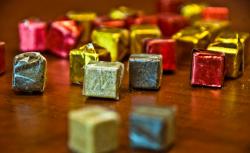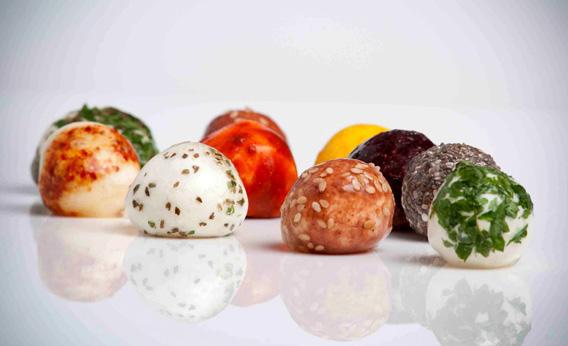Is there a lesson in the nude bananas incident?
Last month, a German-owned “common sense” supermarket chain, Billa, posted a picture of some bananas on its Facebook page. Harmless, right? Except for some reason, the bananas were peeled then packaged in Styrofoam trays wrapped with cellophane. It wasn’t the best PR move for a supposedly “environmentally conscious” company.
The images spread around the Web rapidly. Billa’s Facebook page was so overrun with angry comments that it was temporarily taken down. A spokesman for Greenpeace called what Billa did with the bananas “just madness.” Quickly enough, the company had apologized for its “one off” error.
The reaction to the photo was probably over the top—“Pre-Peeled Bananas Incur the Wrath of Humanity,” Time’s NewsFeed blog declared, tongue in cheek. But the incident highlights a serious issue: In 2010, more than 75 million tons of packaging waste hit landfills in the United States alone, and less than half of that was recovered through recycling, according to the latest available data. And we can’t blame prunes encased in two layers of packaging, shrink-wrapped corn, or even individually wrapped jelly beans for all of that rubbish.
But even if you’re not willing to bring your own containers on food-shopping excursions—as patrons at a new packaging-free grocery store in Austin, Texas, are expected to do—there may be a new solution. Two startup companies want to wrap your food not in plastic that will linger in landfills but in materials that you can eat.
Taking a page from biomimicry—drawing inspiration from nature, as Velcro’s inventor did from burrs—Harvard professor David Edwards and designer François Azambourg have invented WikiCells, which encase various foods and liquids in edible membranes that function like the skin of a grape. WikiCells can hold gazpacho soup, hot chocolate, ice cream, yogurt—almost anything. The membrane itself is made of food particles—say, cheese or dried fruit—and held together by calcium or magnesium ions and alginate. Edwards has even made a grape-flavored pouch filled with wine.
While this solution may dispense with the wasteful primary packaging that actually touches the food, you still need a box or wrapper. So Edwards and his team also developed a number of secondary shells made of caramel, isomalt (rock candy), tapioca, or bagasse, which is what you have left if you take the sugar out of sugar cane. When the casing is made of caramel or isomalt, it’s edible, although that’s not practical for mass distribution for many products—who wants to eat the layer that everyone else in the grocery store fondled, anyway? The bagasse and tapioca versions aren’t edible, but they are compostable. Some companies already use bagasse to make things like food trays. Usually, it’s coated to make it oil- and water-resistant. But because WikiCells’ skin keeps water out (and in) that’s not necessary—you can simply compost the “shell” and wash the WikiCells inside as you would apples or peaches—making the total product more environmentally friendly. So when you buy ice cream bars at the grocery store, each would be wrapped not in plastic but in a WikiCell membrane, flavored, for example, like chocolate chip cookie dough, and the bagasse “shell” or box would hold five or six.
The Indiana company MonoSol is also exploring this space. Earlier this month, MonoSol officially announced its launch of Vivos edible, water-soluble film or polymer. The Vivos packets can hold hot chocolate powder or instant coffee or oatmeal or whey protein drinks. Just place the package in either hot or cold water, and the edible film dissolves. (Here’s a demo). Dissolving, edible packaging could be used in your home kitchen, at restaurants, or even in the military.
Both companies face psychological barriers in getting consumers to eat their packaging. “We understand people are hesitant,” says Sumeet Kumar, senior manager at MonoSol. “People may think … am I eating a plastic? Is that OK?” While it seems strange to watch the film dissolve and then eat it, we actually consume polymers all the time—they coat pharmaceutical pills and are used in breath strips, for instance.

Courtesy MonoSol.
So, how far away are we from seeing these products in stores? For MonoSol, the target date is the end of next year. In late October, in Paris, Edwards and his team will launch the first WikiBar, which will first give out samples in targeted tastings and then sell some products to the general public. By the end of 2013, Edwards hopes that there will be 30 or so WikiBars in the United States and Europe, as well as one or two Wiki-fied items in stores, possibly ice cream or yogurt. Edwards won’t discuss whom he’s working with, but it’s been reported by the U.K.’s Daily Mail that his researchers have worked with Danone, maker of Actimel yogurt drinks and Activa yogurts.
Edwards—who has also invented an inhalable chocolate called Le Whif, inhalable caffeine, and even an inhalable tuberculosis vaccine—also hopes to create WikiCell vending machines and is currently testing out a prototype machine that runs without electricity in a rural community outside of Johannesburg. He imagines a future where mini WikiCell machines sit on kitchen countertops, allowing consumers to design their own packaging, although why, exactly, we might want to do that is unclear, as is how that would actually work in practice.
Ever since the Chinese first coated apples with wax in the second century, entrepreneurs have experimented in edible packaging. Last month, two researchers in South Korea published a paper suggesting an edible packaging made from trout skin. A British company just received a grant to make a spray-on, edible, protective film that could reduce waste from meat packaging. Another collaboration recently produced some lovely if impractical tomato-based containers. (There have also been, meanwhile, some remarkable recent advances in smart packaging.) But the major reason edible packaging hasn’t yet taken off is that companies have struggled to make it cheap, hygienic, and, most important, tasty.
The danger, of course, is that WikiCells and Vivos film could end up just two more in a string of curious novelties, going the way of Crystal Pepsi, Clairol’s Touch of Yogurt Shampoo, and Bic’s disposable pantyhose. But the supermarket chain Billa, at least, is probably paying attention.
This article arises from Future Tense, a collaboration among Arizona State University, the New America Foundation, and Slate. Future Tense explores the ways emerging technologies affect society, policy, and culture. To read more, visit the Future Tense blog and the Future Tense home page. You can also follow us on Twitter.
